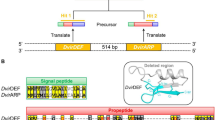Abstract
Upon bacterial infection, insects secrete a set of synthesized antibacterial proteins into the hemolymph and initiate synergistic destruction of invaders. Cecropin is one such antibacterial protein which is also found in vertebrates. To study the evolutionary history and mechanism of the Cecropin gene family, we determined DNA sequences of one isogenic In(3R)C and six isofemale lines of Drosophila melanogaster as well as one line of D. simulans and of D. yakuba. The phylogenetic analysis of these sequences together with those published for D. virilis and Sarcophaga peregrina reveals frequent gene re-organization. It was also found that silent nucleotide differences within D. melanogaster are quite heterogeneous across the gene region of approximately 3 kilobases and the extent of polymorphism is unusually usually high. These data suggest that the Cecropin gene region of D. melanogaster underwent intragenic recombination as well as introgression from a closely related sibling species, D. simulans.
Similar content being viewed by others
Author information
Authors and Affiliations
Additional information
Received: 31 July 1997 / Revised: 24 October 1997
Rights and permissions
About this article
Cite this article
Date, A., Satta, Y., Takahata, N. et al. Evolutionary history and mechanism of the Drosophila Cecropin gene family. Immunogenetics 47, 417–429 (1998). https://doi.org/10.1007/s002510050379
Issue Date:
DOI: https://doi.org/10.1007/s002510050379




